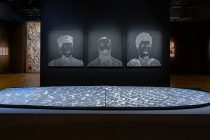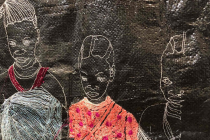Humankind has reached a point of no return. We are all living in a satirical dystopian movie not unlike “They Live,” in which directives functioning as slogans — mere words printed on signs in black lettering against a white background, basically tell people how to live their lives: “No Thought,” “Obey,” “Consume,” “Buy,” “Conform,” “Stay Asleep,” “Watch TV,” “Work 8 Hours,” “Play 8 Hours,” and “Sleep 8 Hours.” Although it would seem like something that would be limited to a hermetically sealed world wherein what is unreal becomes real, in so many ways, we still receive these messages, albeit subliminally or subtly, 28 years after “They Live” was first released in 1988.
These days, while we may think of the year 2016 as an annus horribilis in which the concept of “bread and circuses” (panem et circenses) proved it doesn’t take much for many of us to have our desires satiated, we also realize the contemporary world runs on algorithms, viral dissemination of information, propaganda and technology-driven interconnectivity. Those unexpected moments of enlightenment and performative agency get our attention. A perfect example of this is the video of a black woman, Tashala Dangel Geyer, who painted herself white in a video that has now been viewed by millions of people.
On one hand, there is something poignant and heart-rending about this video. Geyer isn’t the first black person to paint themselves white. Members of the Xhosa tribe who live in South Africa also paint themselves white. A racist 1935 advertisement for Elliott’s White Veneer paint shows a black child painting another black child white; the white paint drips from the child’s face and fingers. The slogan placed above the children’s heads reads, “See How It Covers Over Black.” An early print edition of Jean Genet’s sublime “The Blacks: A Clown Show” shows well dressed characters wearing white masks. In the world of comedy, Dave Chappelle portrayed a white news anchor and his face was painted white. Two Wayans brothers portrayed white women in the movie “White Chicks.” Black artists’ faces were painted white for an event entitled “Be Black Baby: A House Party in Response to Brian DePalma’s 1970 Film “Hi Mom!” Whiteface, though, is nowhere near as prevalent as blackface, and also it is not its equivalent in any respect. Geyer knew this when she made the video in which she painted herself white. Her message was sophisticated, artsy and an act of black existentialism within a surreal atmosphere. Her message was one of survival: she was painting herself white so she would not be shot by cops and become another victim of police brutality. Another hashtag, basically.
A year in which David Bowie, Prince, Muhammad Ali, Zaha Hadid and Leonard Cohen have all passed away, a year that has been brutal on both the political and socio-cultural front, has left many of us wondering what is really going on with humanity. We have now finally reached the Anthropocene age, which basically means humans are having the most impact on the planet in a way that is both profound and consequential. What Tashala Dangel Geyer’s video proves, though, is that human beings are still fighting for dignity, sanctity of life and survival in a regressive atmosphere in which just simply being black is considered an ontological crime. A writer named Clover Hope, writing for Jezebel, referred to Geyer’s body painting video as both “protest” and “performance piece.” Referring to Geyer’s protest as “sad yet whimsical,” Hope explains:
“…The fearless performance piece is a simple, powerful response to black death at the hands of America’s police force…In the video, Geyer addresses her “go white” theory to all the “black families if you wanna survive,” and says “This (is) the best shit I ever could’ve thought of. This saving my life.”
Geyer’s message that, “I see all you niggas, if you wanna survive, I’ma keep saying it: Go white. Just go white. Ooh, you’ll live a long time honey” resonated with many people because underneath the obviously absurd and comedic aspect of satire, there was an underlying and undeniable seriousness. Sometimes we laugh to keep from crying. And sometimes our lives, to borrow a Milan Kundera book title, become a living, veritable book of laughter and forgetting. There is a kind of emotional and intellectual fatigue that comes along with living in the 21st century. Sometimes, it seems that human beings are not only going backwards, but are also repeating the mistakes of the past. In the words of Karl Marx, “History repeats itself, first as tragedy, second as farce.” But what we are experiencing these days could also be described as a tragic farce on an incessant loop.
Predictably, many of the white people who commented on the video could not grasp how they were constructing a false equivalence between blackface and whiteface within the context of the larger discussion surrounding Geyer’s video. The truth is, blackface exists within the domain of white supremacy. There is nothing innocuous, enlightening, valuable or even justifiable about it. Claude Debussy’s “Golliwog’s Cakewalk” and “Minstrels” reference the cultural practice of blackface. Ragtime, a musical genre popularized by black men like composer Scott Joplin and, later, pianist Jelly Roll Morton, was also an inspiration for Debussy, who appropriated it for his classical compositions. Every year, Zwarte Piet is celebrated by Dutch people — it is a racist display that many Dutch people not only embrace but attempt to explain away. Swedish artist Makode Linde’s golliwog cake, which a crowd of white Swedes were photographed laughing at, has been debated, critiqued and discussed at length. When she was a child actress, Shirley Temple wore blackface. Cotton and Chick Watts videos, which show a white man wearing blackface and a leopard print suit, demonstrate how blackface functioned as a backwards, racist, lurid attempt to capture, in caricature form, something no white person could ever really know: the black experience in all of its myriad complexities. Even these days, white people repeatedly wear blackface unapologetically and then pretend to not know how wrong this practice is. What is attached to blackface that is not attached to whiteface is obvious: Jim Crow, disparagement, racism, ridicule, hatred, reductive thinking, and an aesthetic extension of cruelty. A person who wears blackface doesn’t care what a black person thinks of it because the whole point is to also make a joke out of superficially being black in a vacuous way at the expense of black people.
In contrast to blackface, though, Tashala Dangel Geyer painting herself white was sublime and, in retrospect, necessary. It was, in a word, art. There is no difference between Geyer’s body painting video and Vanessa Beecroft’s VB 64 performance art piece staged at Deitch Projects in New York City years ago. The women in Beecroft’s show were all painted white in the main room of the art space. The difference between the two is that Geyer was painting herself while standing up and the women in Beecroft’s show either laid on their backs or sat in different poses. Models of various hues and sizes in the show brought to mind Hellenistic Era statues, Callipygian’s Venus, Gustave Moreau’s La Chimera, Falconet’s La Baigneuse, La Timide’s Shameful Girl, Grand Arabesque by Degas and Jean Auguste Dominique Ingres’s La Sorgente, among others. This was an art experience in which women’s bodies became a canvas. The same could be said of Geyer’s video, which had its own more serious purpose: a protest against police brutality. And because Geyer’s video was both serious satire and made you laugh while focusing on an important issue, perhaps it is she, and not Donald Trump, who should be Person of the Year.
Words Ericka Schiche
Illustration io_designstudios





